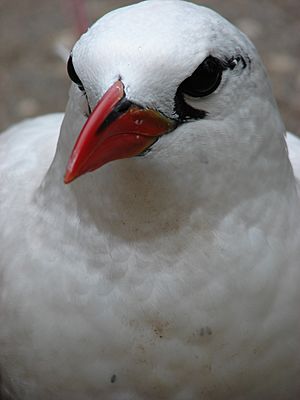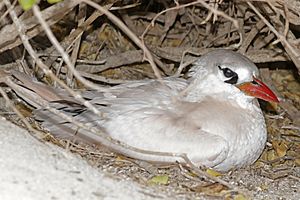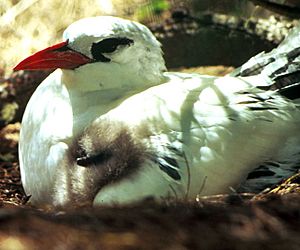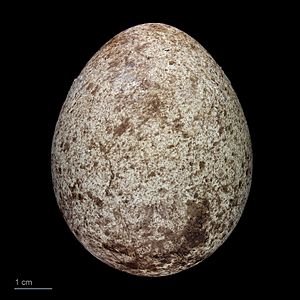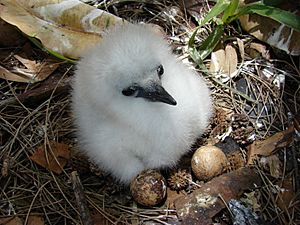Red-tailed tropicbird facts for kids
Quick facts for kids Red-tailed tropicbird |
|
|---|---|
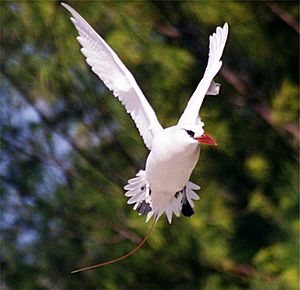 |
|
| Conservation status | |
| Scientific classification | |
| Kingdom: | |
| Phylum: | |
| Class: | |
| Order: | |
| Family: | |
| Genus: | |
| Binomial name | |
| Phaethon rubricauda |
|
The red-tailed tropicbird (Phaethon rubricauda) is a beautiful seabird that makes its home and nests in the Indian Ocean and Pacific Ocean. Even though it's the rarest type of tropicbird, you can find them in many places, and they are not considered in danger. They like to build their nests in large groups, called colonies, on islands far out in the ocean.
Contents
Meet the Red-tailed Tropicbird
The red-tailed tropicbird is about 95 to 104 centimeters (37 to 41 inches) long. This measurement includes its amazing tail feathers, which can be 35 centimeters (14 inches) long! These birds weigh around 800 grams (28 ounces). Their wings can spread wide, from 111 to 119 centimeters (44 to 47 inches).
Most of their feathers are white, sometimes with a pretty pink color. Both male and female birds look very similar. They have a dark, comma-shaped stripe that goes from their nose area, over their eyes, and towards their ears. Their eyes are dark brown.
A special feature is their bright red beak, which is a bit lighter near the bottom and black around the nostrils. Their legs and the base of their toes are a light blue-purple, but the rest of their toes and the webbing between them are black.
The two long tail feathers are orange or red with white bases. These can be hard to spot when the bird is flying. Their white wings have dark, V-shaped marks on some feathers. The pink color is often brighter on the upper part of their wings.
How Young Birds Look
When red-tailed tropicbird chicks first hatch, they are covered in thin, grey-white fluffy feathers called down. Their down is lighter on their heads. As they get older, the down becomes greyer.
After about three weeks, their main flight feathers and shoulder feathers start to show. By six weeks, they are mostly covered in feathers, with some down still under their wings and on their bellies. They are fully feathered by 11 weeks.
Young birds have shiny white feathers on their forehead, chin, throat, and belly. They also have clear black stripes and scales on their head, neck, back, and upper wing feathers. Their beaks are grey-black with a light blue-grey base, and their legs and feet are grey.
Bird Calls
Red-tailed tropicbirds are usually quiet when they fly. When they are courting, they might make a short squawk to greet their mate. If they feel threatened, they make a low growling sound. Young birds make a fast, chattering sound when they are begging for food from their parents.
Where Red-tailed Tropicbirds Live
The red-tailed tropicbird lives across the southern Indian Ocean, and the western and central Pacific Ocean. You can find them from the coast of Africa all the way to Indonesia, near Japan, across to Chile, and in the Hawaiian Islands. They are more common on the northwestern Hawaiian islands.
Large groups of these birds breed on islands like Europa, Aldabra, and Christmas Island in the Indian Ocean. Smaller groups live in Madagascar, the Seychelles, and Mauritius. In Australia, they nest on coral islands in Queensland and off Western Australia. They also breed on islands in New Zealand, Fiji, New Caledonia, and French Polynesia.
These birds like ocean areas where the water temperature is warm, usually between 24 to 30 degrees Celsius (75 to 86 degrees Fahrenheit). They spread out widely after they finish breeding.
Red-tailed Tropicbird Behavior
The red-tailed tropicbird is a very strong flyer. However, it has trouble walking on land and moves with a shuffling walk.
Reproduction and Nesting
Red-tailed tropicbirds are believed to stay with the same mate for many breeding seasons. They nest in loose groups on islands, rocky cliffs, and coral atolls. They rarely nest on large landmasses.
Their nest is a shallow scrape (a small dip in the ground). They usually make it in shaded sand, a rocky crack, or under a bush. Since they don't walk well, they land by flying into the wind, slowing down, and dropping to the ground. They often choose a nest spot close to the edge of a shaded area to avoid walking far.
These birds protect their nest area. They can become aggressive, especially in crowded colonies where good nest spots are hard to find. They might raise their wings, pull their neck in, shake their head, fluff up their head feathers, and squawk. Sometimes, they even fight by locking beaks and wrestling for a long time.
The length of a bird's tail feathers might help them find a mate, with longer tails being more attractive. Birds also seem to choose mates with similar tail lengths.
Before breeding, males perform a special dance in the air. They fly in large circles, gliding, flapping their wings fast, and flying low over the water while making sharp calls. They start in small groups, then pair off to do the dance together before they become a couple.
The timing of breeding depends on where they live. In some places, they have a set breeding season, but in others, they breed all year round. Near the equator, they usually lay eggs from June to November.
The female red-tailed tropicbird lays only one egg. Both parents take turns sitting on the egg for 42 to 46 days to keep it warm. The male usually takes the first turn. The oval-shaped eggs are pale tan with brown and red-black marks, which are darker on the wider end. They are about 5.4 to 7.7 centimeters (2.1 to 3 inches) long.
When chicks hatch, they are helpless and cannot move much. They are blind at first, opening their eyes after 2 or 3 days. For the first week, they only open their beak if touched, so parents gently stroke their beak to get them to eat. Parents feed them once or twice a day, usually around midday. Chicks stay in the nest for 67 to 91 days until they are ready to fly.
What They Eat
The red-tailed tropicbird mostly catches its food by diving into the water. They can dive from 6 to 50 meters (20 to 164 feet) above the water, going about 4.5 meters (15 feet) deep. When they dive, they stay underwater for a short time, usually around 26 seconds. They often swallow their prey before coming back to the surface. Sometimes, they even catch flying fish in the air!
Their diet mainly includes squid and flying fish. They also eat some crustaceans, like crabs or shrimp, depending on where they are. They can carry surprisingly large prey for their size. For example, parent birds have been seen bringing fish that weighed 120 grams (4.2 ounces) to their chicks. That's about 16% of their own body weight!
Body Temperature
When these birds are sitting on their nest during the day in the shade, their body temperature is about 39 degrees Celsius (102 degrees Fahrenheit). At night, it's a bit lower, around 37.1 degrees Celsius (98.8 degrees Fahrenheit). After flying, their average body temperature is about 40.9 degrees Celsius (105.6 degrees Fahrenheit). Their feet are always cooler than their body during flight but warmer than the air. This means their feet likely help them cool down while flying.
Red-tailed Tropicbirds and People
The long tail feathers of the red-tailed tropicbird were highly valued by the Maori people in New Zealand. The Ngāpuhi tribe would collect these feathers from dead birds that washed ashore after storms. They would then trade them for greenstone with other tribes. An English naturalist named Andrew Bloxam also reported that the feathers were prized in Hawaii. Locals there would gently pull the feathers from the birds while they were nesting.
Images for kids
-
Flying backwards courtship ritual. Kīlauea Point, Hawaii
See also
 In Spanish: Ave del trópico de cola roja para niños
In Spanish: Ave del trópico de cola roja para niños



